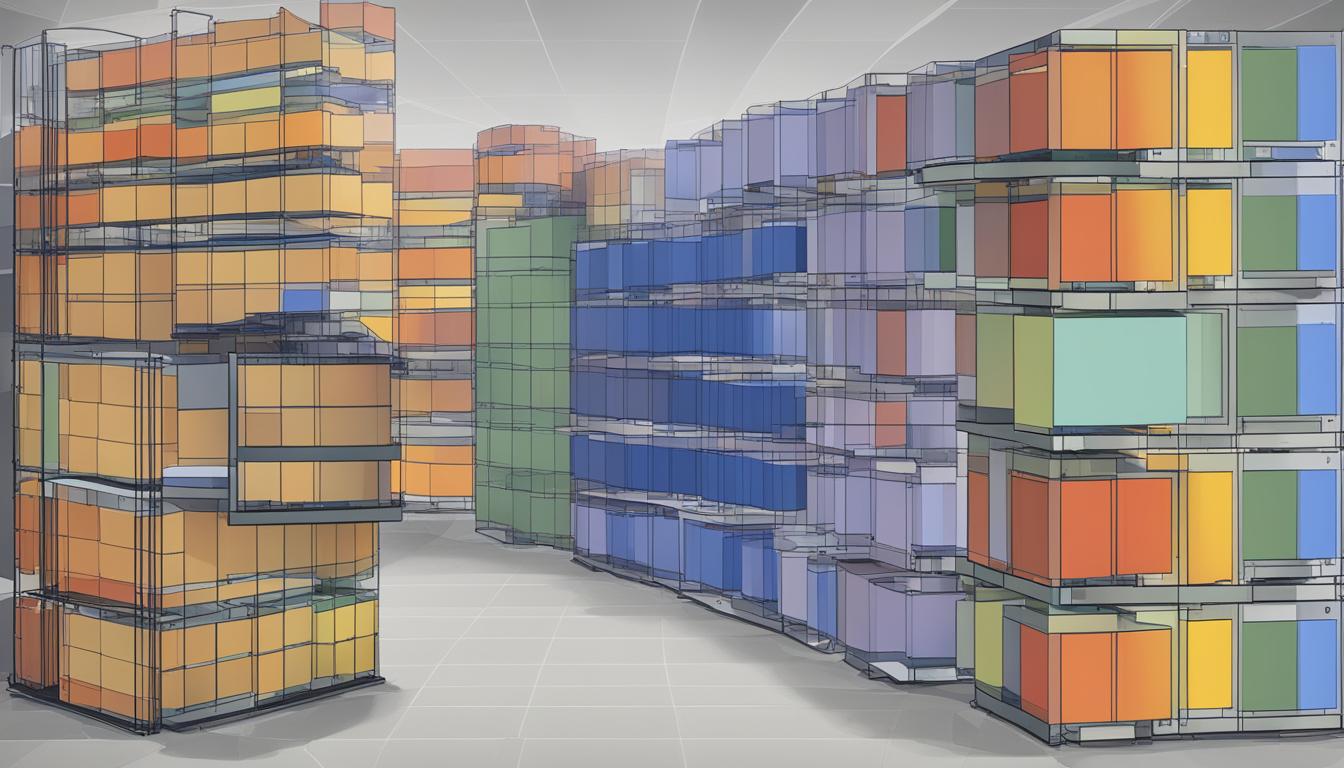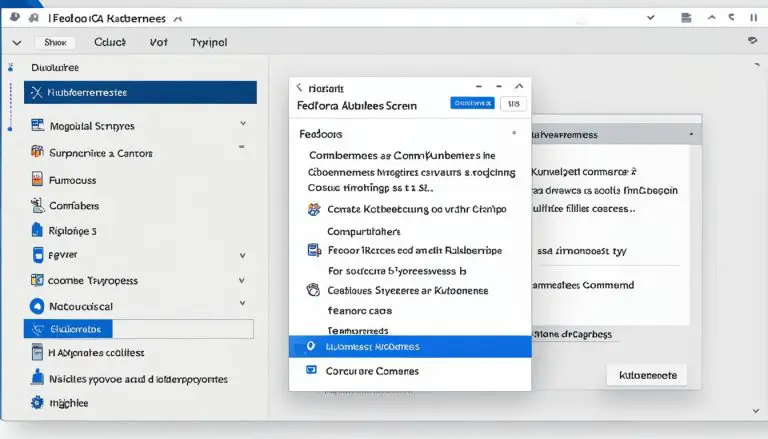Understanding What is Ext4 (Fourth Extended Filesystem)
I’ll take you through the ins and outs of ext4, the fourth extended filesystem, and its importance in the world of Linux. With improved performance and enhanced storage capabilities, ext4 has become a key component of Linux systems. Let’s dive in and explore what makes ext4 an essential file system for Linux users.
Key Takeaways:
- Ext4 is the successor to ext3 and offers improved performance and storage capabilities for Linux systems.
- The ext filesystem family has evolved over the years, with ext4 being the latest and most advanced version.
- Ext4 supports larger file systems, backward compatibility with ext3, and incorporates journal checksums for enhanced reliability.
- The ext4 filesystem architecture utilizes metadata structures, inodes, and efficient block allocation mechanisms for data storage.
- Ext4 brings performance improvements through delayed allocation, multiblock allocation, and lazy initialization techniques.
The Evolution of Ext Filesystems
The ext filesystem family has undergone significant evolution over the years, with each version building upon the successes and addressing the limitations of its predecessors. It all began in 1992 with the introduction of ext, which brought improvements to the original Minix filesystem. In 1993, ext2 was introduced as a more advanced version, adding support for large files and file system sizes up to 4 terabytes. The ext3 filesystem, released in 2001, introduced journaling capabilities, providing enhanced data integrity and recovery options in case of system crashes or power failures.
However, the ext4 filesystem, introduced in 2006, marked a major milestone in the evolution of ext filesystems. Ext4 brought significant performance improvements and storage capabilities compared to its predecessors. It features support for larger file systems, allowing files up to 16 terabytes in size. Extents, a key feature of ext4, improve the performance of large files by reducing fragmentation. Ext4 also offers backward compatibility with ext3, enabling seamless upgrades for users without sacrificing existing data.
The ext4 filesystem is currently the latest and most advanced version in the ext family. It offers improved timestamps, enhanced storage capabilities, and better performance compared to ext3. Ext4 has become the default filesystem in many Linux distributions, cementing its position as the go-to choice for Linux users. While the ext family of filesystems continues to evolve, ext4 remains a reliable and widely used option for data storage in Linux systems.
| Ext Filesystem | Year Introduced | Key Features |
|---|---|---|
| ext | 1992 | – Improvement over Minix filesystem – Limited file system size support |
| ext2 | 1993 | – Support for large files and file system sizes up to 4TB |
| ext3 | 2001 | – Introduction of journaling capabilities – Enhanced data integrity and recovery options |
| ext4 | 2006 | – Support for larger file systems and files up to 16TB – Extents for improved large file performance – Backward compatibility with ext3 |
Features of Ext4
The ext4 filesystem brings several notable features that enhance its performance and storage capabilities. These features make it a reliable choice for Linux users and ensure smooth data management. Let’s delve into some of these key features:
Large File System Support
One of the standout features of ext4 is its ability to support larger file systems. With ext4, you can handle files up to an impressive 16 TiB in size. This is a significant improvement compared to its predecessors, making it suitable for storage-intensive applications and environments that require handling large files and volumes.
Extents for Improved Performance
Ext4 introduces the concept of extents, which greatly enhances performance when dealing with large files. Instead of storing individual blocks, extents allow for a more efficient storage mechanism by grouping contiguous blocks together. This reduces fragmentation and improves read and write performance for large files.
Backward Compatibility with Ext3
Ext4 maintains backward compatibility with its predecessor, ext3. This means that you can seamlessly upgrade from ext3 to ext4 without any data loss or compatibility issues. It provides a smooth transition path, allowing users to take advantage of the improved performance and features of ext4 without disrupting their existing file systems.
Journal Checksums for Enhanced Reliability
Ext4 incorporates journal checksums, which ensure the integrity and reliability of file system operations. By verifying the checksums of journal entries, ext4 can detect and correct any inconsistencies that may occur during data transactions. This feature enhances both the performance and dependability of the filesystem.
Overall, the ext4 filesystem offers a range of powerful features that contribute to its performance, reliability, and backward compatibility. With its support for larger file systems, utilization of extents, backward compatibility with ext3, and implementation of journal checksums, ext4 provides an excellent choice for Linux users seeking efficient and robust data storage solutions.
Ext4 Filesystem Architecture
When it comes to the architecture of the ext4 filesystem, several key components work together to provide a robust and efficient data storage solution. Understanding these components is essential for gaining insight into how ext4 operates.
Metadata Structures
At the core of ext4’s architecture are its metadata structures, which provide a logical framework for organizing and storing data. These structures include the superblock, block and inode bitmaps, block groups, and the journal. The superblock contains essential information about the filesystem, such as its size and block size. The bitmaps track the allocation status of data blocks and inodes, while block groups divide the filesystem into manageable units. The journal, which will be discussed further in Section 6, enables filesystem recovery in the event of a crash or power loss.
Inodes
An important concept in ext4 is the inode, which stands for “index node”. Inodes store metadata about files, including their size, ownership, timestamps, and pointers to data blocks where the file’s contents are stored. By using inodes, ext4 can efficiently manage file attributes and facilitate quick file access. The inode table, which contains all the inodes, is a critical component of the filesystem’s architecture.
Block Allocation
Block allocation in ext4 is handled through various mechanisms to optimize data storage. Extents, introduced in ext4, are used to efficiently allocate and manage large file data blocks. Extents allow files to be stored contiguously on the disk, improving performance and reducing fragmentation. In addition to extents, ext4 uses other allocation methods, such as bitmaps, to allocate and manage data blocks effectively.
By employing these architectural elements, ext4 is able to provide a reliable and high-performance filesystem for Linux systems.
Performance Improvements in Ext4
Ext4 introduces several performance improvements compared to its predecessors, making it a reliable choice for users looking for enhanced efficiency and speed in their file system. Some of the key performance enhancements in Ext4 include:
Delayed Allocation
One notable improvement in Ext4 is the implementation of delayed allocation. This feature optimizes file system performance by allocating larger amounts of data at a time, reducing fragmentation. By allocating data in larger chunks, Ext4 minimizes the number of disk seeks required for read and write operations, resulting in improved overall performance.
Multiblock Allocator
The introduction of the multiblock allocator in Ext4 significantly improves file allocation performance, especially for files with multiple concurrent writers. This enhancement allows Ext4 to allocate multiple blocks at once, eliminating the need for repeated disk seeks. As a result, Ext4 can efficiently handle file operations involving multiple writers, improving overall system performance.
Lazy Initialization
Ext4 incorporates lazy initialization, which accelerates the initialization process by performing background cleaning of inode tables. This optimization allows the file system to initialize more quickly, reducing the time required for system startup or mounting large file systems. By deferring certain initialization tasks, Ext4 improves the overall responsiveness of the file system.

These performance improvements make Ext4 a powerful and efficient file system choice for users seeking optimal performance and reliability. Whether it is the delayed allocation for reduced fragmentation, the multiblock allocator for enhanced file allocation, or the lazy initialization for faster system startup, Ext4 offers significant performance enhancements over its predecessors.
Journaling in Ext4
Journaling plays a crucial role in ensuring the integrity and recoverability of the ext4 filesystem. By recording changes before they are committed to the disk, journaling protects against data inconsistencies in the event of a system failure. Ext4 offers three journaling modes: journal, ordered, and writeback. Each mode has its own trade-offs between performance and data safety, allowing users to choose the level of protection that suits their needs.
Journal Mode:
In this mode, all file system metadata updates are recorded in the journal before being written to their respective locations on the disk. This ensures that the file system can be accurately recovered in case of a crash. However, the performance impact of journal mode can be significant due to the need to write the same data twice – once to the journal and once to the actual file system.
Ordered Mode:
In ordered mode, data updates are first written to the journal before the corresponding file system metadata. This maintains the consistency of the file system, as metadata changes are always recorded before the associated data. While this mode reduces the risk of file system corruption, it still incurs some performance overhead.
Writeback Mode:
Writeback mode prioritizes performance over data safety. In this mode, only metadata updates are journaled, while data updates are written directly to the file system without being logged. This approach maximizes performance but increases the risk of data inconsistencies in case of a crash or power failure.
Overall, journaling in ext4 provides users with flexibility in balancing performance and data safety. By offering different journaling modes, ext4 allows users to tailor the file system behavior based on their specific requirements and use cases.
| Journaling Mode | Performance | Data Safety |
|---|---|---|
| Journal | Medium | High |
| Ordered | Medium | Medium |
| Writeback | High | Low |
Table: Ext4 Journaling Modes
Ext4 and Large Filesystem Support
Ext4, the fourth extended filesystem, is designed to meet the requirements of modern storage-intensive applications and environments that handle large files and volumes. With its enhanced capabilities, Ext4 offers support for large filesystems, allowing users to store and manage vast amounts of data efficiently.
Ext4 supports maximum volume sizes up to 1 EiB (exbibyte), which is equivalent to 1,152,921,504 TiB (tebibytes). This vast storage capacity makes Ext4 suitable for scenarios where extensive data storage is necessary, such as big data analytics, scientific research, and enterprise-level applications.
Furthermore, Ext4 can handle files up to 16 TiB (tebibytes) in size, depending on the block size used. This file size capability is significantly larger than its predecessors, making Ext4 an ideal choice for multimedia applications, large databases, and other use cases that involve handling massive files.
Ext4 Large Filesystem Support
| Feature | Description |
|---|---|
| Maximum Volume Size | Support for up to 1 EiB (exbibyte) of storage capacity |
| Maximum File Size | Ability to handle files up to 16 TiB (tebibytes) depending on block size |
The large filesystem support of Ext4 is a result of its advanced storage management techniques, such as the use of extents and optimized block allocation mechanisms. These features allow for efficient storage allocation, reduced fragmentation, and improved performance when dealing with large files and volumes.
Overall, Ext4’s ability to handle large filesystems and files positions it as a reliable and powerful solution for modern data storage needs. Its widespread adoption and integration into various Linux distributions further attest to its stability and effectiveness in real-world scenarios.
Ext4 Adoption and Usage
The ext4 file system has gained widespread adoption and has become the default file system for many Linux distributions, including Debian and Ubuntu. Its stability, performance improvements, and backward compatibility with ext3 have made it a popular choice for Linux users. Ext4 offers numerous advantages and features that make it an ideal choice for handling data storage in Linux environments.
One of the key reasons for the widespread adoption of ext4 is its improved performance compared to its predecessors. Ext4 introduces several performance enhancements, such as delayed allocation, which improves performance by allocating larger amounts of data at a time, reducing fragmentation. The multiblock allocator optimizes file allocation, especially for files with multiple concurrent writers, further boosting performance. Additionally, lazy initialization facilitates background cleaning of inode tables, accelerating filesystem initialization.
Ext4 is not only limited to Linux distributions but is also widely used in other operating systems, such as FreeBSD and macOS. Its versatility and compatibility have made it a go-to choice for handling data storage needs in a variety of environments. As a result, it has gained a solid reputation for reliability and efficiency.
Benefits of Ext4 Adoption
- Stability: Ext4 is a mature and well-established file system, ensuring stability and reliability in data storage.
- Performance: The performance improvements in ext4, including delayed allocation and multiblock allocator, contribute to faster data access and improved overall system performance.
- Backward Compatibility: Ext4 retains backward compatibility with ext3, allowing for seamless upgrades without data loss or disruption.
- Large Filesystem Support: Ext4’s ability to support large filesystems, with maximum volume sizes up to 1 EiB, makes it suitable for storage-intensive applications.
- Wide Adoption: Ext4 is the default file system in many Linux distributions, ensuring widespread usage and community support.
In conclusion, ext4 has garnered significant adoption in the Linux community, becoming the default file system for many popular distributions. Its stability, performance improvements, and compatibility have made it a reliable choice for handling data storage needs. The versatility of ext4 extends beyond Linux, with its usage extending to other operating systems as well. As the industry continues to evolve, ext4 will remain a trusted and widely used file system until a suitable replacement is developed.
| Benefits of Ext4 Adoption |
|---|
| Stability |
| Performance |
| Backward Compatibility |
| Large Filesystem Support |
| Wide Adoption |
Ext4 and Future Developments
As technology continues to advance, the ext4 filesystem remains a reliable and widely used choice for Linux systems. However, developers are working on next-generation filesystems that aim to overcome the limitations of ext4 and provide even greater performance and capabilities. These future developments are driven by the need for more efficient data storage and increased scalability.
One potential next-generation filesystem is Btrfs (B-tree filesystem), which is currently under development. Btrfs offers several advantages over ext4, including support for snapshots, improved data integrity features, and built-in RAID functionality. With Btrfs, users can benefit from enhanced reliability, scalability, and performance, making it a promising candidate for the future of Linux filesystems.
Another emerging filesystem is ZFS (Zettabyte File System), originally developed by Sun Microsystems and now supported by various operating systems, including Linux. ZFS is known for its advanced features, such as data deduplication, data compression, and snapshots. These features contribute to improved storage efficiency and data protection. While ZFS is not currently the default filesystem for Linux distributions, its popularity and potential make it a strong contender for next-generation filesystems.
| Next-Generation Filesystems | Features |
|---|---|
| Btrfs | Support for snapshots, improved data integrity, built-in RAID |
| ZFS | Data deduplication, data compression, snapshots |
While ext4 continues to be widely used and supported, it is important to stay informed about the advancements in next-generation filesystems. As these new filesystems mature and gain wider adoption, they may eventually replace ext4 as the default choice for Linux systems. However, for now, ext4 remains a reliable and efficient filesystem that meets the needs of many users.
Conclusion
In conclusion, ext4 is a mature and robust filesystem that has significantly improved the performance and storage capabilities of Linux systems. With its roots dating back to the Minix operating system, ext4 has evolved from ext, ext2, and ext3 to become the latest and most advanced version. It offers features such as support for larger filesystems, extents for improved performance, and backward compatibility with ext3.
The ext4 filesystem architecture is built on a solid foundation, utilizing metadata structures and inodes to provide efficient data storage. Performance improvements in ext4 include delayed allocation, a multiblock allocator, and lazy initialization, which optimize file allocation, reduce fragmentation, and accelerate filesystem initialization.
Journaling is a crucial component of ext4, ensuring filesystem consistency and recovery in case of crashes or power losses. With three journaling modes available – journal, ordered, and writeback – users have the flexibility to choose the level of protection they require. Additionally, ext4 supports large filesystems, making it suitable for storage-intensive applications and environments that handle large files and volumes.
While the development of next-generation filesystems is underway, ext4 remains an integral part of Linux systems. Its stability, performance improvements, and widespread adoption as the default filesystem in many Linux distributions contribute to its continued usage and support. Ext4 provides reliable data storage and will continue to play a significant role until a suitable replacement emerges.
FAQ
What is ext4?
Ext4, short for Fourth Extended Filesystem, is a key component of Linux systems. It is a filesystem that provides improved performance and storage capabilities compared to its predecessors.
How does ext4 relate to previous ext filesystems?
Ext4 is the latest version in the ext filesystem family, which includes ext, ext2, and ext3. Each iteration brought improvements and addressed limitations of its predecessor, with ext4 being the most advanced version.
What are the notable features of ext4?
Ext4 supports larger file systems and can handle files up to 16 TiB in size. It introduces the concept of extents to improve large file performance and reduce fragmentation. Ext4 is also backward compatible with ext3 and incorporates journal checksums for enhanced reliability and performance.
How is the ext4 filesystem structured?
Ext4 utilizes metadata structures such as inodes to provide a logical framework for data storage. Inodes store information about files, and block allocation is handled through mechanisms like extents and bitmaps.
What performance improvements does ext4 offer?
Delayed allocation reduces fragmentation by allocating larger amounts of data at a time. The multiblock allocator optimizes file allocation, especially for files with multiple concurrent writers. Lazy initialization accelerates filesystem initialization by facilitating background cleaning of inode tables.
What is journaling in ext4?
Journaling ensures filesystem consistency and recovery in the event of a crash or power loss. Ext4 offers three journaling modes: journal, ordered, and writeback, each offering a different balance between performance and data safety.
Does ext4 support large filesystems?
Yes, ext4 is designed to support large filesystems. It has a maximum volume size of up to 1 EiB and can handle files up to 16 TiB in size, depending on the block size used.
How widely adopted is ext4?
Ext4 is widely adopted and has become the default filesystem for many Linux distributions, including Debian and Ubuntu. Its stability, performance improvements, and backward compatibility with ext3 have made it a popular choice for Linux users. It is also used in other operating systems like FreeBSD and macOS.
What is the future of ext4?
While ext4 is expected to be replaced by future filesystems, it remains an integral part of Linux systems and will continue to be supported and used until a suitable replacement is developed.
- About the Author
- Latest Posts
Mark is a senior content editor at Text-Center.com and has more than 20 years of experience with linux and windows operating systems. He also writes for Biteno.com






